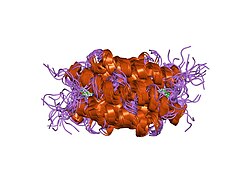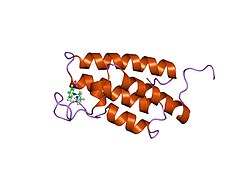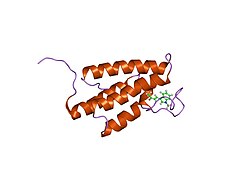Biology:PCAF
 Generic protein structure example |
P300/CBP-associated factor (PCAF), also known as K(lysine) acetyltransferase 2B (KAT2B), is a human gene and transcriptional coactivator associated with p53.
Structure
Several domains of PCAF can act independently or in unison to enable its functions. PCAF has separate acetyltransferase and E3 ubiquitin ligase domains as well as a bromodomain for interaction with other proteins. PCAF also possesses sites for its own acetylation and ubiquitination.[1]
Function
CBP and p300 are large nuclear proteins that bind to many sequence-specific factors involved in cell growth and/or differentiation, including c-jun and the adenoviral oncoprotein E1A. The protein encoded by the PCAF gene associates with p300/CBP. It has in vitro and in vivo binding activity with CBP and p300, and competes with E1A for binding sites in p300/CBP. It has histone acetyl transferase activity with core histones and nucleosome core particles, indicating that this protein plays a direct role in transcriptional regulation.[2]
Regulation
The acetyltransferase activity and cellular location of PCAF are regulated through acetylation of PCAF itself. PCAF may be autoacetylated (acetylated by itself) or by p300. Acetylation leads to migration to the nucleus and enhances its acetyltransferase activity.[3] PCAF interacts with and is deacetylated by HDAC3, leading to a reduction in PCAF acetyltransferase activity and cytoplasmic localisation.[4]
Protein interactions
PCAF forms complexes with numerous proteins that guide its activity. For example PCAF is recruited by ATF[5] to acetylate histones and promote transcription of ATF4 target genes.
Targets
There are various protein targets of PCAF's acetyltransferase activity including transcription factors such as Fli1,[6] p53[7] and numerous histone residues. Hdm2, itself a ubiquitin ligase that targets p53, has also been demonstrated to be a target of the ubiquitin-ligase activity of PCAF.[1]
Interactions
PCAF has been shown to interact with:
See also
References
- ↑ 1.0 1.1 "Intrinsic ubiquitination activity of PCAF controls the stability of the oncoprotein Hdm2". Nat. Cell Biol. 9 (3): 331–8. March 2007. doi:10.1038/ncb1545. PMID 17293853.
- ↑ "Entrez Gene: PCAF p300/CBP-associated factor". https://www.ncbi.nlm.nih.gov/sites/entrez?Db=gene&Cmd=ShowDetailView&TermToSearch=8850.
- ↑ "Mechanisms of P/CAF auto-acetylation". Nucleic Acids Res. 31 (15): 4285–92. August 2003. doi:10.1093/nar/gkg655. PMID 12888487.
- ↑ "Histone deacetylase 3 interacts with and deacetylates myocyte enhancer factor 2". Mol. Cell. Biol. 27 (4): 1280–95. February 2007. doi:10.1128/MCB.00882-06. PMID 17158926.
- ↑ "The p300/CBP-associated factor (PCAF) is a cofactor of ATF4 for amino acid-regulated transcription of CHOP". Nucleic Acids Res. 35 (17): 5954–65. 2007. doi:10.1093/nar/gkm642. PMID 17726049.
- ↑ "Transforming growth factor-beta regulates DNA binding activity of transcription factor Fli1 by p300/CREB-binding protein-associated factor-dependent acetylation". J. Biol. Chem. 282 (48): 34672–83. November 2007. doi:10.1074/jbc.M703907200. PMID 17884818.
- ↑ "p53 sites acetylated in vitro by PCAF and p300 are acetylated in vivo in response to DNA damage". Mol. Cell. Biol. 19 (2): 1202–9. February 1999. doi:10.1128/MCB.19.2.1202. PMID 9891054.
- ↑ "M phase-specific phosphorylation of BRCA2 by Polo-like kinase 1 correlates with the dissociation of the BRCA2-P/CAF complex". J. Biol. Chem. 278 (38): 35979–87. Sep 2003. doi:10.1074/jbc.M210659200. PMID 12815053.
- ↑ "BRCA2 associates with acetyltransferase activity when bound to P/CAF". Oncogene 17 (19): 2531–4. Nov 1998. doi:10.1038/sj.onc.1202475. PMID 9824164.
- ↑ "PCAF acetylates {beta}-catenin and improves its stability". Mol. Biol. Cell 20 (1): 419–27. Jan 2009. doi:10.1091/mbc.E08-08-0792. PMID 18987336.
- ↑ "Association of CBP/p300 acetylase and thymine DNA glycosylase links DNA repair and transcription". Mol. Cell 9 (2): 265–77. Feb 2002. doi:10.1016/S1097-2765(02)00453-7. PMID 11864601.
- ↑ 12.0 12.1 "A human RNA polymerase II complex containing factors that modify chromatin structure". Mol. Cell. Biol. 18 (9): 5355–63. Sep 1998. doi:10.1128/MCB.18.9.5355. PMID 9710619.
- ↑ "Interaction of EVI1 with cAMP-responsive element-binding protein-binding protein (CBP) and p300/CBP-associated factor (P/CAF) results in reversible acetylation of EVI1 and in co-localization in nuclear speckles". J. Biol. Chem. 276 (48): 44936–43. Nov 2001. doi:10.1074/jbc.M106733200. PMID 11568182.
- ↑ "Transcriptional activation by hepatocyte nuclear factor-1 requires synergism between multiple coactivator proteins". J. Biol. Chem. 275 (17): 12515–20. Apr 2000. doi:10.1074/jbc.275.17.12515. PMID 10777539.
- ↑ 15.0 15.1 "The histone acetylase PCAF is a phorbol-ester-inducible coactivator of the IRF family that confers enhanced interferon responsiveness". Mol. Cell. Biol. 19 (3): 1810–20. Mar 1999. doi:10.1128/MCB.19.3.1810. PMID 10022868.
- ↑ "Coactivator p300 acetylates the interferon regulatory factor-2 in U937 cells following phorbol ester treatment". J. Biol. Chem. 276 (24): 20973–80. Jun 2001. doi:10.1074/jbc.M101707200. PMID 11304541.
- ↑ "Functional interaction between coactivators CBP/p300, PCAF, and transcription factor FKLF2". J. Biol. Chem. 277 (9): 7029–36. Mar 2002. doi:10.1074/jbc.M108826200. PMID 11748222.
- ↑ "MDM2 inhibits PCAF (p300/CREB-binding protein-associated factor)-mediated p53 acetylation". J. Biol. Chem. 277 (34): 30838–43. Aug 2002. doi:10.1074/jbc.M204078200. PMID 12068014.
- ↑ 19.0 19.1 "c-Myc transformation domain recruits the human STAGA complex and requires TRRAP and GCN5 acetylase activity for transcription activation". J. Biol. Chem. 278 (22): 20405–12. May 2003. doi:10.1074/jbc.M211795200. PMID 12660246.
- ↑ "Steroid receptor coactivator-1 is a histone acetyltransferase". Nature 389 (6647): 194–8. Sep 1997. doi:10.1038/38304. PMID 9296499. Bibcode: 1997Natur.389..194S.
- ↑ "Functional interaction between the mouse notch1 intracellular region and histone acetyltransferases PCAF and GCN5". J. Biol. Chem. 275 (22): 17211–20. Jun 2000. doi:10.1074/jbc.M000909200. PMID 10747963.
- ↑ "Regulation of E2A activities by histone acetyltransferases in B lymphocyte development". J. Biol. Chem. 278 (4): 2370–6. Jan 2003. doi:10.1074/jbc.M211464200. PMID 12435739.
- ↑ "The p400 complex is an essential E1A transformation target". Cell 106 (3): 297–307. Aug 2001. doi:10.1016/s0092-8674(01)00450-0. PMID 11509179.
- ↑ "Regulation of histone acetyltransferases p300 and PCAF by the bHLH protein twist and adenoviral oncoprotein E1A". Cell 96 (3): 405–13. Feb 1999. doi:10.1016/S0092-8674(00)80553-X. PMID 10025406.
External links
- PCAF protein, human at the US National Library of Medicine Medical Subject Headings (MeSH)
- NURSA C105
Further reading
- "Multiple modes of transcriptional regulation by the HIV-1 Tat transactivator.". IUBMB Life 51 (3): 175–81. 2002. doi:10.1080/152165401753544241. PMID 11547919.
- "Tat Acetylation: A Regulatory Switch between Early and Late Phases in HIV Transcription Elongation". Reversible Protein Acetylation. Novartis Foundation Symposia. 259. 2004. pp. 182–93; discussion 193–6, 223–5. doi:10.1002/0470862637.ch13. ISBN 978-0-470-86263-6.
- "HIV-1 infection and regulation of Tat function in macrophages". Int. J. Biochem. Cell Biol. 36 (9): 1767–75. 2005. doi:10.1016/j.biocel.2004.02.018. PMID 15183343.
- "HIV-1 tat protein and cell proliferation and survival: a brief review". New Microbiol. 28 (2): 95–109. 2005. PMID 16035254.
- "Decoding Tat: the biology of HIV Tat posttranslational modifications". Microbes Infect. 7 (13): 1364–9. 2006. doi:10.1016/j.micinf.2005.06.003. PMID 16046164.
- "The multiple functions of HIV-1 Tat: proliferation versus apoptosis". Front. Biosci. 11: 708–17. 2006. doi:10.2741/1829. PMID 16146763.
- "The regulation of HIV-1 transcription: molecular targets for chemotherapeutic intervention". Med Res Rev 26 (5): 595–625. 2007. doi:10.1002/med.20081. PMID 16838299.
- "Will diverse Tat interactions lead to novel antiretroviral drug targets?". Current Drug Targets 7 (12): 1595–606. 2007. doi:10.2174/138945006779025338. PMID 17168834.
- "Treatment of Haemophilus aphrophilus endocarditis with ciprofloxacin". J. Infect. 24 (3): 317–20. 1992. doi:10.1016/S0163-4453(05)80037-4. PMID 1602151.
- "A p300/CBP-associated factor that competes with the adenoviral oncoprotein E1A". Nature 382 (6589): 319–24. 1996. doi:10.1038/382319a0. PMID 8684459. Bibcode: 1996Natur.382..319Y.
- "The transcriptional coactivators p300 and CBP are histone acetyltransferases". Cell 87 (5): 953–9. 1997. doi:10.1016/S0092-8674(00)82001-2. PMID 8945521.
- "Steroid receptor induction of gene transcription: a two-step model". Proc. Natl. Acad. Sci. U.S.A. 94 (15): 7879–84. 1997. doi:10.1073/pnas.94.15.7879. PMID 9223281. Bibcode: 1997PNAS...94.7879J.
- "Nuclear receptor coactivator ACTR is a novel histone acetyltransferase and forms a multimeric activation complex with P/CAF and CBP/p300". Cell 90 (3): 569–80. 1997. doi:10.1016/S0092-8674(00)80516-4. PMID 9267036.
- "Steroid receptor coactivator-1 is a histone acetyltransferase". Nature 389 (6647): 194–8. 1997. doi:10.1038/38304. PMID 9296499. Bibcode: 1997Natur.389..194S.
- "TRAM-1, A novel 160-kDa thyroid hormone receptor activator molecule, exhibits distinct properties from steroid receptor coactivator-1". J. Biol. Chem. 272 (44): 27629–34. 1997. doi:10.1074/jbc.272.44.27629. PMID 9346901.
- "Transcription factor-specific requirements for coactivators and their acetyltransferase functions". Science 279 (5351): 703–7. 1998. doi:10.1126/science.279.5351.703. PMID 9445475. Bibcode: 1998Sci...279..703K.
- "Differential roles of p300 and PCAF acetyltransferases in muscle differentiation". Mol. Cell 1 (1): 35–45. 1998. doi:10.1016/S1097-2765(00)80005-2. PMID 9659901.
- "Histone-like TAFs within the PCAF histone acetylase complex". Cell 94 (1): 35–44. 1998. doi:10.1016/S0092-8674(00)81219-2. PMID 9674425.
- "Identification and mapping of human histone acetylation modifier gene homologues". Genomics 51 (2): 262–9. 1998. doi:10.1006/geno.1998.5370. PMID 9722949.
- "Activation of integrated provirus requires histone acetyltransferase. p300 and P/CAF are coactivators for HIV-1 Tat". J. Biol. Chem. 273 (38): 24898–905. 1998. doi:10.1074/jbc.273.38.24898. PMID 9733796.
This article incorporates text from the United States National Library of Medicine, which is in the public domain.
 |






